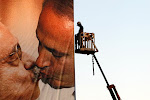Hammering Cruci-fiction? Simcha nails it

That Orthodox chap who calls himself the Naked Archaeologist is at it again, timing another dubious documentary to coincide with Easter. The garrulous and guileless Simcha Jacobovici claims to have dug up a couple of 2000 year old nails used to crucify Jesus, and the discovery is making serious archaeologists and Biblical scholars rather cross. It definitely is intended to spike the interest of Christendom, and Simcha called a press conference in Jerusalem to launch the publicity for his new film. Reuters reports on the controversy stirred up by the Sabra/Canuk director's latest release: "The Nails of the Cross":
"What we are bringing to the world is the best archaeological argument ever made that two of the nails from the crucifixion of Jesus have been found," he said in an interview with Reuters.
"Do I know 100 percent yes, these are them? I don't."
The film begins by revisiting an ancient Jerusalem grave discovered in 1990 which was hailed by many at the time as the burial place of the Jewish high priest Caiaphas, who in the New Testament presides over the trial of Jesus.
The grave, along with a number of ossuaries, or bone boxes, was uncovered during construction work on a hillside a few kilometers south of the Old City. It has since been resealed.
Caiaphas is a major figure in the Gospels, having sent Jesus to the Romans and on to his death, and one of Jacobovici's assertions is that the high priest was not such a bad guy.
Two iron nails were found in the tomb, one on the ground and one actually inside an ossuary, and, according to the film, mysteriously disappeared shortly after. Jacobovici says he tracked them down to a laboratory in Tel Aviv of an anthropologist who is an expert on ancient bones.
And if they are indeed the same nails -- eaten away by rust and bent at the end, almost purposefully -- was their disappearance a conspiracy or a logistical slip-up?
No definite answer is offered.
Either way, Jacobovici shows why those nails could have been used in a crucifixion, which was a common practice two thousand years ago. He then offers his theory about why they may have been used in the most famous crucifixion in history.
"If you look at the whole story, historical, textual, archaeological, they all seem to point at these two nails being involved in a crucifixion," he said. "And since Caiaphas is only associated with Jesus's crucifixion, you put two and two together and they seem to imply that these are the nails."
The Israel Antiquities Authority, which oversaw the Jerusalem excavation, said in reaction to the film's release that it had never been proven beyond doubt that the tomb was the burial place of Caiaphas. It also said that nails are commonly found in tombs.
"There is no doubt that the talented director Simcha Jacobovici created an interesting film with a real archaeological find at its center, but the interpretation presented in it has no basis in archaeological findings or research," it said.




















No comments:
Post a Comment